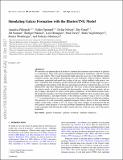Simulating Galaxy Formation with the IllustrisTNG Model
Author(s)
Pillepich, Annalisa; Springel, Volker; Nelson, Dylan; Genel, Shy; Naiman, Jill; Pakmor, Rüdiger; Hernquist, Lars; Torrey, Paul; Vogelsberger, Mark; Weinberger, Rainer; Marinacci, Federico; ... Show more Show less
DownloadAccepted version (9.220Mb)
Terms of use
Metadata
Show full item recordAbstract
© 2017 The Authors. We introduce an updated physical model to simulate the formation and evolution of galaxies in cosmological, large-scale gravity+magnetohydrodynamical simulations with the moving mesh code AREPO. The overall framework builds upon the successes of the Illustris galaxy formation model, and includes prescriptions for star formation, stellar evolution, chemical enrichment, primordial and metal-line cooling of the gas, stellar feedback with galactic outflows, and black hole formation, growth and multimode feedback. In this paper, we give a comprehensive description of the physical and numerical advances that form the core of the IllustrisTNG (The Next Generation) framework.We focus on the revised implementation of the galactic winds, of which we modify the directionality, velocity, thermal content and energy scalings, and explore its effects on the galaxy population. As described in earlier works, the model also includes a new black-hole-driven kinetic feedback at low accretion rates, magnetohydrodynamics and improvements to the numerical scheme. Using a suite of (25Mpc h-1)3 cosmological boxes, we assess the outcome of the new model at our fiducial resolution. The presence of a selfconsistently amplified magnetic field is shown to have an important impact on the stellar content of 1012M⊙ haloes and above. Finally, we demonstrate that the new galactic winds promise to solve key problems identified in Illustris in matching observational constraints and affecting the stellar content and sizes of the low-mass end of the galaxy population.
Date issued
2018Department
Massachusetts Institute of Technology. Department of Physics; MIT Kavli Institute for Astrophysics and Space ResearchJournal
Monthly Notices of the Royal Astronomical Society
Publisher
Oxford University Press (OUP)